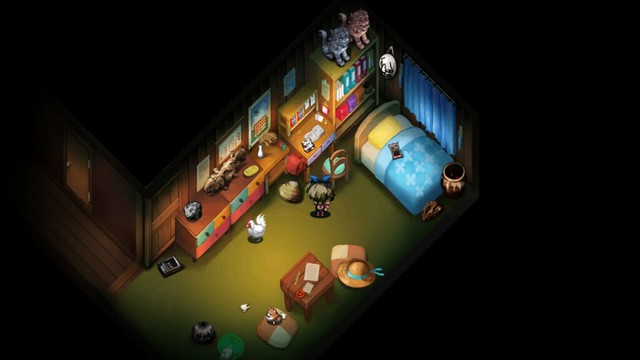At the outset of Yomawari, I was absolutely captivated by its impressively understated visuals and its cute characters, but within fifteen minutes of beginning the game, I knew that the games appearance was simply a front for more a much more sinister sequence of events. Most of your time will be spent playing as Haru, a young girl that is searching for her best friend Yui. There are short scenes between chapters where players take control of Yui, but these merely serve to show how near (or far) Haru is from finding her.
Yomawari is played from an isometric perspective, which makes it feel like a 16-bit JRPG. It also shares a similar graphical style to games from that era, but the world is much, much more richly detailed, in particular with its use of colour which is almost always exceptional throughout. Haru, Yui and other friendly characters are almost always cute and lovable, whilst the ghosts that also occupy their world range from genuinely gruesome in the case of the scissor-demon to quite sad, such as the little boy who forlornly kicks his ball up and down the road.
You see, Midnight Shadows is a game about death (or perhaps the fear of it) through the eyes of a child, and the visual style matches perfectly with the storyline, which is delivered in a fairly minimalist way. The game is centred around the two friends visiting a fireworks festival on the first night, during which Yui gets lost. From that point on, Haru sets out to find Yui every single night, with each night of adventuring and exploring the town in which they are struck forming the structure of the game.
Neither Haru nor Yui can defend themselves against the spirits that occupy the town, which is, by now, a well-used way of increasing tension in video games. Yomawari does it better than most however, providing Haru with a torch that sometimes enables her to freeze or scare away spirits, whilst more often than not she’ll simply be running from the ones that threaten her. One interesting thing about Yomawari is the fact that not all spirits actually threaten her, with many of them simply offering light investigative puzzle solving opportunities, or providing a physical barrier.
This is perhaps one of the best things about Yomawari, because there is such a variety of spirits that you’ll often take a moment to work out whether something just looks scary, or is actually going to kill you. In either case, this leads to lots of running away and evading enemies, which causes Haru’s stamina gauge to deplete. Some spirits are invisible, and you can tell when you are getting closer to them via the beating of Haru’s heart, which becomes increasingly panicked as she gets closer and closer to whatever might be there.
This is a great way of increasing the players level of engagement, because among other environmental effects such as flickering lights or dripping water, Yomawari uses sound extremely effectively. It has almost no incidental music, but due to the frequency of Haru’s rhythmic heartbeat and the smart use of sound, Yomawari oozes atmosphere that I never would have expected from a game that looks this cute and simplistic.
Actually working your way through the world of Yomawari involves a fair bit of backtracking from night to night, but Haru’s ability to circumnavigate spirits by one means or another mean that there is always a new place to visit or a previously blocked area to pass through and explore. This structure means that you’ll rarely know when a bigger, scarier ghost is going to appear, which makes it all the scarier. As Haru’s heartbeat increases at the sight of some of these ghosts, I promise, so will yours!
Yomawari: Midnight Shadows may only take about five or so hours to complete, which (in my opinion) makes it a little expensive, but it is very enjoyable whilst it lasts. Thanks largely to the coin-based save system and the lack of combat, it is quite easy, but much of the reason for playing it is driven by the story, which is delivered exceptionally well considering how little traditional storytelling it includes. It deals with an interesting concept – death – in a unique and interesting way, and it doesn’t outstay its welcome. My verdict?







